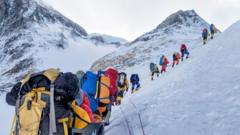The climbing permit fees for Mount Everest are set to increase for the first time in nearly a decade, with officials stating that the new costs aim to address the long-standing issues surrounding the number of climbers and the maintenance required for the world's highest peak.
From September, climbers will need to pay $15,000 (£12,180) for a peak season permit to summit Everest, marking a 36% rise from the previous fee of $11,000. The adjusted pricing will also apply to off-peak seasons, increasing to $7,500 during the months from September to November and $3,750 from December to February.
This fee increase is crucial for Nepal's revenue, which relies significantly on tourism, with climbing and trekking representing over 4% of the national economy. However, there is ongoing criticism from mountaineering experts regarding the excessive number of climbers permitted each year, typically around 300.
According to Narayan Prasad Regmi, the director general of the Department of Tourism, the royalty fees had not seen a review for a considerable time and needed to be updated. However, details on how the generated extra revenue will be utilized remain unclear.
British mountaineer Kenton Cool, who has summited Everest 18 times, remarked that a price increase was expected and likely wouldn't deter most foreign climbers due to the overall cost of such an expedition. He expressed hope that the additional funds would be used effectively.
In a noteworthy ruling from April 2024, Nepal's Supreme Court ordered the government to limit the issuance of mountaineering permits for Everest and other peaks, emphasizing respect for the mountains' capacity. However, no specific caps were detailed in the preliminary order.
Amid rising concerns of congestion on Everest, where climbers often find themselves queuing in perilous conditions, the Nepalese army initiated an annual clean-up effort in 2019. To date, this initiative has recovered 119 tonnes of rubbish alongside 14 bodies and some skeletons, but estimates suggest that an additional 200 remains are yet to be found.
Nepal, home to eight of the world's 14 highest peaks, continues to face challenges in managing tourism sustainably while balancing economic needs with environmental and safety considerations.
From September, climbers will need to pay $15,000 (£12,180) for a peak season permit to summit Everest, marking a 36% rise from the previous fee of $11,000. The adjusted pricing will also apply to off-peak seasons, increasing to $7,500 during the months from September to November and $3,750 from December to February.
This fee increase is crucial for Nepal's revenue, which relies significantly on tourism, with climbing and trekking representing over 4% of the national economy. However, there is ongoing criticism from mountaineering experts regarding the excessive number of climbers permitted each year, typically around 300.
According to Narayan Prasad Regmi, the director general of the Department of Tourism, the royalty fees had not seen a review for a considerable time and needed to be updated. However, details on how the generated extra revenue will be utilized remain unclear.
British mountaineer Kenton Cool, who has summited Everest 18 times, remarked that a price increase was expected and likely wouldn't deter most foreign climbers due to the overall cost of such an expedition. He expressed hope that the additional funds would be used effectively.
In a noteworthy ruling from April 2024, Nepal's Supreme Court ordered the government to limit the issuance of mountaineering permits for Everest and other peaks, emphasizing respect for the mountains' capacity. However, no specific caps were detailed in the preliminary order.
Amid rising concerns of congestion on Everest, where climbers often find themselves queuing in perilous conditions, the Nepalese army initiated an annual clean-up effort in 2019. To date, this initiative has recovered 119 tonnes of rubbish alongside 14 bodies and some skeletons, but estimates suggest that an additional 200 remains are yet to be found.
Nepal, home to eight of the world's 14 highest peaks, continues to face challenges in managing tourism sustainably while balancing economic needs with environmental and safety considerations.






















